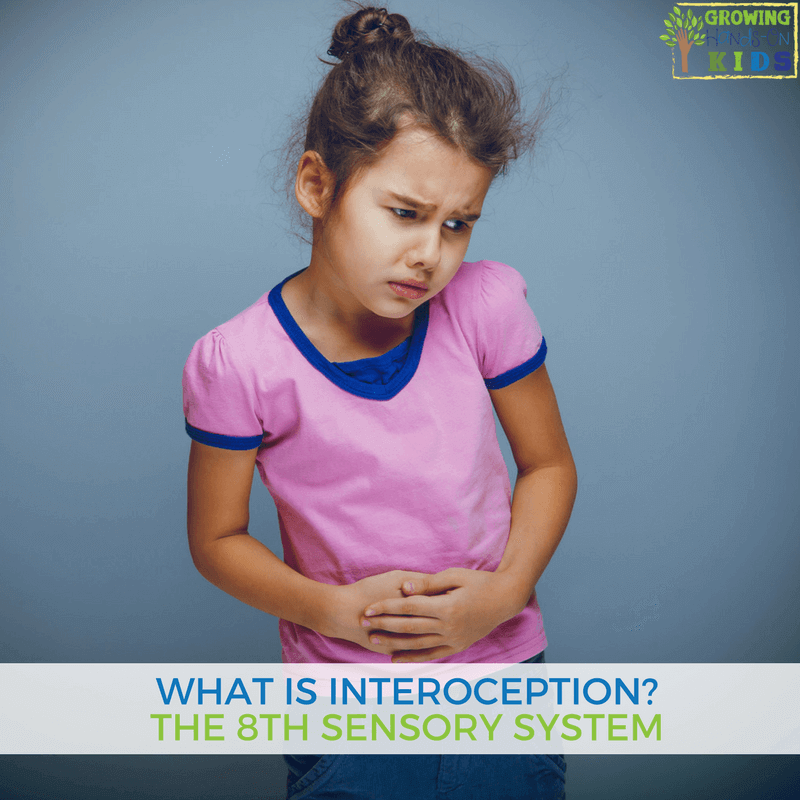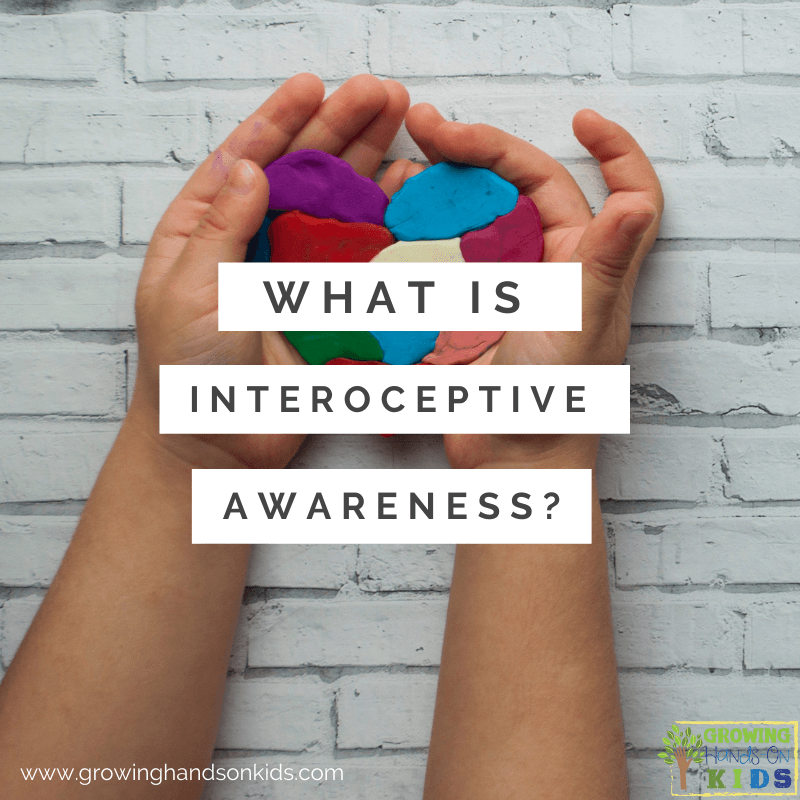How To Understand Interoception: An Explanation Of The 8th Sensory System
Affiliate and Referral links are used below to promote products I love and recommend. I receive a commission on any purchases made through these links. Please see my disclosure policy for more details. As an Amazon Associate, I earn from qualifying purchases.
Until a couple of years ago, I had never heard about interoception. When I attended a continuing education class about behavior and sensory processing, interoception was mentioned. It intrigued me and I decided to research more.
Interoception is the awareness of bodily sensations. It is the sense of knowing the internal condition of your body. I explain what the 8th sensory system is and how it works below.
Interoception Table of Contents
- What are the 8 senses?
- What is Interoception?
- A simple explanation of Interoception
- Hyper-Responsive and Hypo-Responsive Interoception Reactions
- What Interoception Sensitivities to look for
- Interoception and Self-Regulation Skills
- Activity Strategies for Interoception Sensitivity
- Free Handout on Interoception and the 8 Senses
What are the 8 senses?
Before we get started on discussing Interception, I want to give a brief review of all the sensory systems.
The sensory system is part of the nervous system responsible for processing sensory information. The sensory system consists of sensory receptors, neural pathways, and parts of the brain involved in sensory perception.
What are the 8 senses?
Most people learn about the 5 common senses, but not everyone knows there are really 8. I didn’t even realize there were 8 until a few years ago. I knew there were 7, but the 8th one surprised me.
So what are they?
- Tactile/Touch
- Auditory/Hearing
- Visual/Sight
- Gustatory/Taste
- Olfactory/Smell
- Proprioception
- Vestibular
- Interoception
If you would like more basic information on all 8 sensory systems, you can check out my post on all 8 senses of the sensory system here. I also have a free 9-day e-mail series on sensory processing that gives you one-page printables for each system throughout the series.
What is Interoception?
Interoception is the sense of knowing what is going on INSIDE our bodies.
Things such as feeling:
- Hunger
- Thirst
- Tired
- Feeling pain
- Temperature (Feeling hot or cold etc)
- Needing to use the bathroom
- Emotional regulation and moods
- Any other internal sensations
A simple explanation of Interoception
Don’t worry, I’m not getting too technical here.
We’ve already learned that interoception is internal body sensations.
Your body is filled with sensory receptors that tell you where your body parts are. These proprioceptive receptors are located in your muscles and joints. This helps you to understand what is going on around you and how your body moves within that environment.
Something similar goes on with Interoceptive input, except that the interoception receptors are inside your body’s organs and skin. All of these receptors report to your brain with information about what is going on INSIDE your body.
This all helps to regulate your body functions such as:
- Feeling hungry or thirsty
- How fast or slow your heart is beating (heart rate)
- Digestion
- Needing to use the toilet (bladder feeling full etc)
- Body temperature regulation
- Emotional regulation and moods
A good example of this is a commercial by Snickers®. The commercial portrays a character who is “hangry” or angry because they are hungry. Often times we have an EMOTIONAL response to what we are feeling inside our bodies. Some people may become angry or moody when they are hungry. When you begin to feel this way, most of the time you know you need to get something to eat and your mood improves.
Imagine you have to go to the bathroom but you can’t find a place to go. You most likely become anxious, frantically looking for the nearest options out of fear that you may not make it in time. You may notice your heart beating faster, your palms sweating, or breathing heavier until you find relief!
You can thank your interoception system for all these feelings and reactions to what is going on inside.
Hyper-Responsive and Hypo-Responsive Interoception Reactions
Just like the other 7 sensory systems, children can be hyper-responsive or hypo-responsive to interoceptive sensory input.
Hyper-responsive, also known as over-responsive or hypersensitive means a child is extremely sensitive to this input. The slightest sensation of hunger, thirst, or bathroom needs can cause them to be extremely anxious. The slightest change in temperature or even hearing their own heartbeat can be extremely distracting. Some of the sensations they feel could even be extremely painful.
Children who are hypersensitive to interoception input may be extremely distracted by sensations such as hunger or having to use the bathroom. In some cases, these sensations can even be painful. They may have trouble maintaining focus on a task because they are distracted by what is going on inside their body.
Hypo-responsive, also known as under-responsive or hypo-sensitive means a child often needs a large amount of input in order to recognize the type of sensory information their brain is receiving. This means they may not realize the need to use the restroom, or they may not realize they are hungry until they are completely starving. And the same with feeling thirsty. They might not realize they are in pain or the sensation of pain feels completely different to them, like a tickle.
Children who are hypo-sensitive to interoception input may not even be aware of the cues their body is giving them to the sensations inside their body. They simply aren’t getting enough information to process what is going on.
This means they may not feel when they need to go to the bathroom, resulting in accidents or difficulty with potty training.
They may never feel full after a meal or they may never feel hungry. They may not respond to pain the same way as you and I might. A broken bone may not even phase them. Or the slightest scratch or cut may cause extreme pain and anxiety.
All of these can result in safety issues and difficulty functioning in a typical environment.
What Interoception Sensitivities to look for
Interoception sensitivities may affect those who have been diagnosed with ADHD, Autism, SPD (Sensory Processing Disorder), Anxiety, eating disorders, depression, and even obesity.
Children who are experiencing sensory processing challenges have trouble making sense of the information that their brain is receiving. They may not be able to tell when they feel pain or when their bladder is full. A common sensation such as an itch may feel extremely painful, or pain may feel like tickling.
Here is an easy explanation of interoceptive sensitivities to look for:
- Difficulty with toileting (bed wetting and accidents)
- Unable to track hydration or food intake (never feel thirsty or hungry. Or may always feel thirsty or hungry)
- Difficulty in recognizing and communicating internal body states or sensations (feeling hot/cold, pain, etc)
- Difficulty regulating emotions and feelings (not feeling they are angry before they verbally or physically lash out)
- Distracted by internal sensory input such as hearing their heartbeat
- Unable to tell how loud their voice is in an environment. May use sound to cover up unwanted sensory stimuli
Interoception and Self-Regulation Skills
Interoception difficulties can also make self-regulation a challenge. When you are able to tell that you’re thirsty, you know to get a drink. When you can feel that your bladder is full, you know to use the bathroom. When you feel a sense of frustration, you know to explain what’s troubling you.
Some children with interoception difficulties, can’t regulate certain responses. Some kids may experience bedwetting. Or they may not know why they’re feeling off and can have meltdowns. Kids who struggle with these things may not be able to identify the real source of their discomfort.
Those who struggle with interoception input can also have difficulties with “feeling” emotion. They may not be as aware or tuned in to their body’s cues that can help to interpret that emotion. This makes it difficult for them to identify emotions. For example, a child may not “feel” fear because he doesn’t recognize that his muscles are tense, his breathing is shallow and his heart is racing.
Activity Strategies for Interoception Sensitivity
More research needs to be done in order to find more evidence-based activities that target interoceptive input. However, here are a few ideas that are based on current thought and research.
– Mindfulness activities and meditation (encourages children to be more aware of what is going on inside their bodies)
– Yoga for kids
– Creating a sensory diet to address sensitivities (make sure to work with a licensed Occupational therapist who is familiar with sensory processing)
– Repetitive and rhythmic vestibular input (such as swinging, rocking, etc)
– Visual prompts, cues, or communication devices that encourage children to identify body functions and feelings
– Verbally labeling emotions as we see them and also responding appropriately to encourage functional responses.
– Help your child to communicate wants, needs, emotions, and feelings by first recognizing them and then communicating them appropriately (social stories could be helpful for this).
You can also check out my 10 Interoception Activities for Kids post here.
Free Handout on Interoception and the 8 Senses
I have a free handout on interoception, as well as the other 7 sensory systems available below.
Subscribe to Growing Hands-On Kids for weekly newsletter activity tips and ideas, just like this one. You'll also be the first to know about new printables, products, and recommended resources.
You'll also be receiving my 9-day sensory processing tips email series. You can unsubscribe at any time.
By downloading this free printable, you are agreeing with my site's terms of use and privacy policy as detailed here.
FREE DOWNLOAD FOR INTEROCEPTION
Enter your email address below and click the blue “click here” button. Your handout will be sent directly to your inbox.
You will receive a handout with all 8 sensory systems, including interoception in this download.
Resources:
Sensory Processing Explained: A Complete Guide for Parents and Educators by Sharla Kostelyk and Heather Greutman, COTA
Interoception: How I Feel: Sensing My World from the Inside Out by Dr. Cara Koscinski, OTD, MOT, OTR/L.
You May Also Like:

Heather Greutman, COTA
Heather Greutman is a Certified Occupational Therapy Assistant with experience in school-based OT services for preschool through high school. She uses her background to share child development tips, tools, and strategies for parents, educators, and therapists. She is the author of many ebooks including The Basics of Fine Motor Skills, and Basics of Pre-Writing Skills, and co-author of Sensory Processing Explained: A Handbook for Parents and Educators.






Thank you for this information. This is really resonating with me. I do have some queries though. My son seems unable to react to bodily changes like getting too hot or being hungry/thirsty for a long time but then it will suddenly kick in (like he will suddenly say he’s really thirsty). He will go all day at forest school sometimes eating and drinking very little but when I pick him up he will then want so much water he can’t stop drinking. I often pick him up and he is so sweaty as he has obviously over heated but has not removed any clothing.
So my questions are:
1) Does this disorder mean that they never recognise their body’s cues or does it just delay them until they cannot ignore them anymore?
2) Can they just be hyposensitive to certain things? For example I think he has a normal pain response
3) I’m based in the UK and wondered how I would get a diagnosis for this as it seems quite a new area?
Many thanks for your helpful website!!!
Thank you for this info! My son has autism and suffered kidney faliar 3 years ago because of hydronithropaty – the bladder pushed liquid into the kidneys from being held up, no feeling of full bladder!!! . This was ascribed to autism related “neorophatic bladder & bowels” . It shows how serious the absence/suppression of introspection can be……
Hi Mari, oh wow, I bet that was scary! Thanks for sharing your story.
When you need something, the world brings it to you! I knew I would think of a child in my class as I started reading, but I ended up understanding two – one likely hypersensitive ( very articulate but “simply”cries when hungry, or touched by others, etc) and one hypersensitive who never makes it to the bathroom, and has atypical emotional reactions).
I think this will be super helpful in planning for these children to help them both be more successful in a classroom. Thank you.
(Edit : I meant to say HYPO-SENSITIVE for the second child)
Hi, I’m a child psychiatrist specializing in neurodevelopmental disorders and have a long time interest in sensory processing disorders related to neurodevelopmental damage from prenatal exposures. Since the nervous system begins to develop very early – week 2 after conception and 50% of pregnancies are unplanned, common lifestyle behaviors such as alcohol use can lead to very subtle nerve damage (not just neurocognitive problems) associated with sensory hypo- or hyper- sensitivities.
I’d be interested to know how much information you’ve come across (in general sources available to the public) about the link between sensory processing disorders and alcohol use prior to pregnancy recognition.
Hi Susan. I would love to email you about our case. I have been mourning what our son coukd have been if I had known I was pregnant earlier. I was young and naive. We pay for it every day of our lives having to support our beautiful boy who has special needs. I will give you an address to contact me on ginnihope88@gmail.com
Thanks, this was really interesting. Miss 3 has strong sensory sensitivities so I’ve done lots of research on the first 7 senses, I hadn’t realized there was a name for the 8th but it reflects a lot of our challenges. Interesting to know she’s not the only one who uses ‘tickling’ to refer not only to tickling, but also to a light sensation, a bearable/endurable sensation, and pain; i.e. a hot pavement might ‘tickle’ her feet and it might take her a while to realize that it’s actually too hot and hurting as she’s normally hypo on her lower half.
Shared to Facebook.
My son has Autism, and global development delay I recognise some of what’s going on here as he doesn’t really feel pain, temperatures don’t bother him etc
The main problem we are having is toileting he’s 7 and still in nappies, he will go to the toilet to urinate in the day time when we take him every hour or so. But other than that it’s like he has no control we just can’t seem to make any progress.
Any advice on how to get him to recognise when he needs to go?
This is so important and can shed light on a lot of the sensory issues a child may be having. While more research needs to be done (all sensory issues do!), this is an intriguing area of future study. Thanks for explaining it so clearly and bringing attention to it.
Best,
Diana
Can a child be a combination of hyper and hypo sensitive? Example: My daughter is hypersensitive to temperature, hunger and emotions but hyposensitive to the sensation of going to the bathroom or pain signals.
Yes Rose, that is very possible!
My son is both hypo and hyper. Which causes so much anxiety with him. He’s also going through a growth spurt right and the pain in his legs is excruciating. He often has meltdowns that can last for days. Especially at times like this where he can feel change happening in his body. He is 10. I also have to monitor is food and servings because he never feels full but then that can lead to overeating and then an upset tummy. SPD is constantly changing as he gets older. And some days are no challenge at all and the next day can be a really bad day. Occupational Therapy has helped him tremendously!
My daughter is the same. She can present both and depending on if she is hyper or hypo before a trigger she can have different meltdowns. Either completely shuts down or she can get really high pitched and squeaky and cross and stamp about. One day we can have a really lovely ‘normal’ day and the next I can’t even get her to sch. We’re trying to find triggers to help and strategies for bringing her out of her meltdowns. Suggestions welcomed.
I knew my son had issues like this but didn’t have a name and didn’t have ideas on how to help him. Tha k you for sharing!!!! My only question would be why at 2 was he not phased by a blood draw or shot but now at 5 he freaks out at the mention of a shot? Is he changing with age or is it anxiety making him upset??
Hi Aimee,
Thanks for your comment. It could be both. I know my daughter was not afraid of loud noises when she was younger, but now she is and we have to use noise-canceling headphones if we know are going to be in a loud situation (like a concert or movie).
HI,
Thank you for this information. I’d love to know more about the science behind this. Could you provide the publications with the research and data?
Thanks!
Reading this article was like a lightbulb moment! Suddenly so much that is going on with my kids makes sense to me. I feel like I can actually deal with what’s going on in our lives. When you are given a diagnosis of spd and high functioning autism that’s pretty much it. It would be so much better if the professionals in these fields were to give information like this in appointments,then parents might not feel so helpless/powerless to help their child. We haven’t been diagnosed long and I find I’m learning more every day about my special little angels. There’s never a dull moment! Thank you.
This would fall under Vagus nerve regulation?
I can’t believe I found this thread!! My daughter was diagnosed with hypotonia dyspraxia, spd and a lot of the points you spoke about are so right.
8th sense is something that hasn’t been mentioned to this extent before? The information you have shared is something I can add to my research more list 🙂